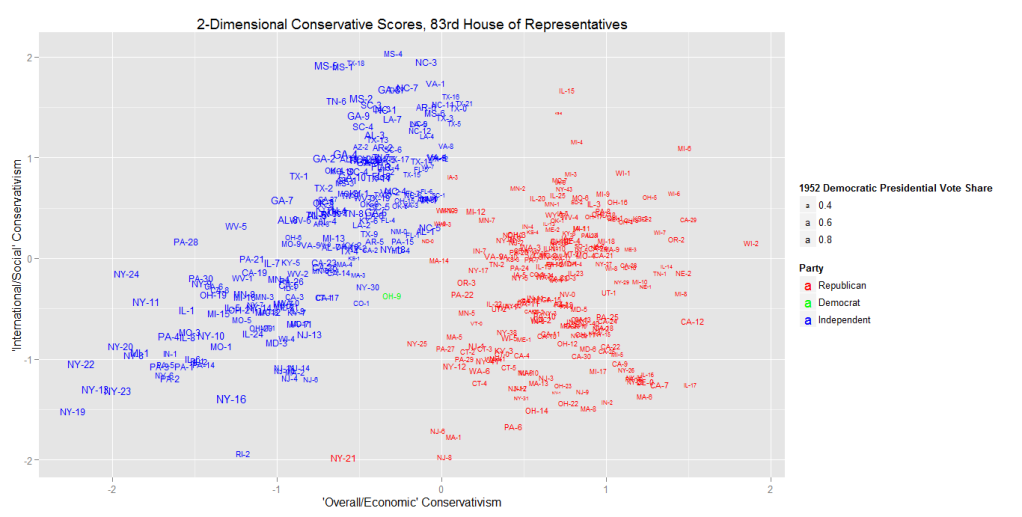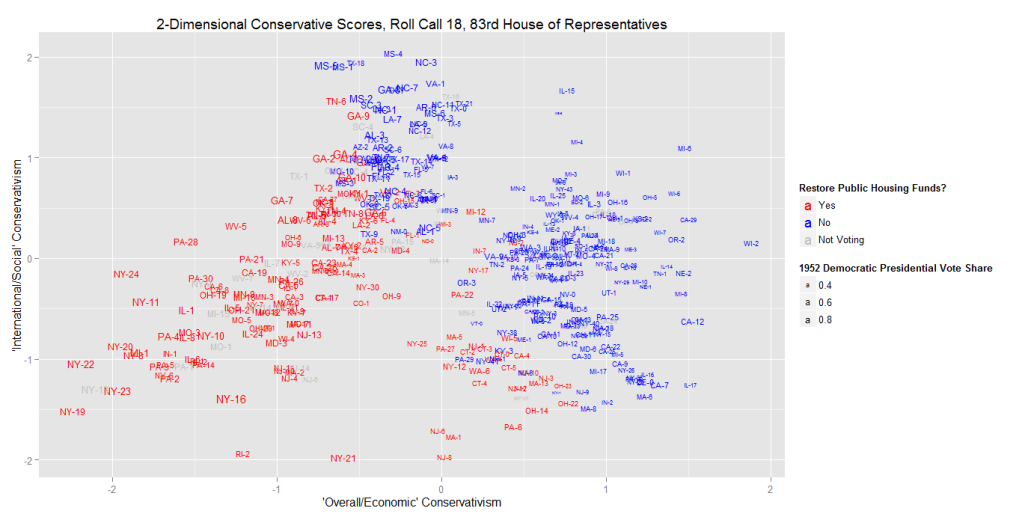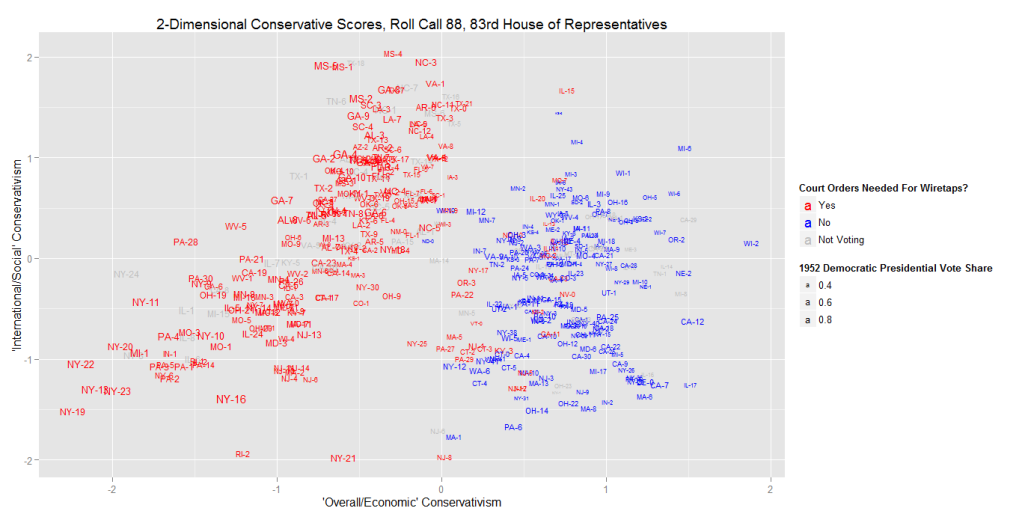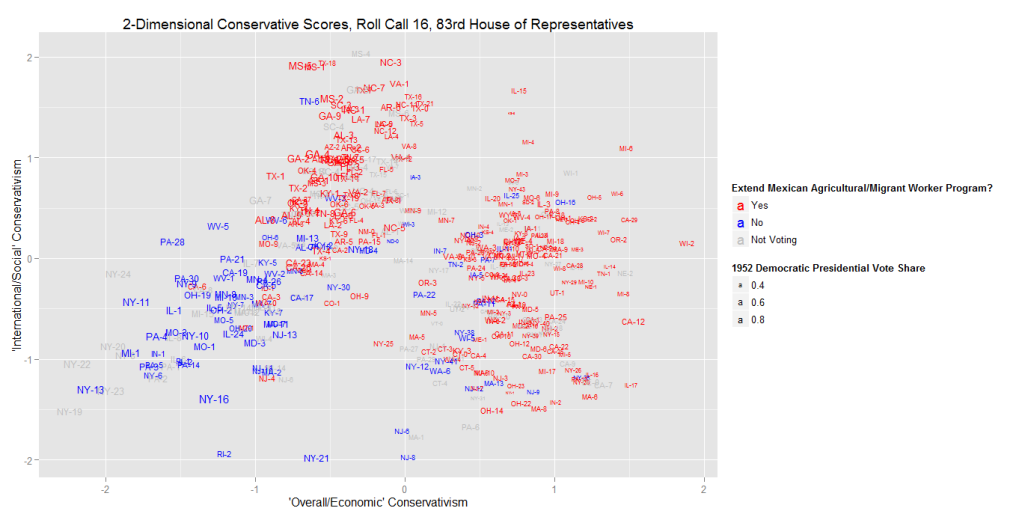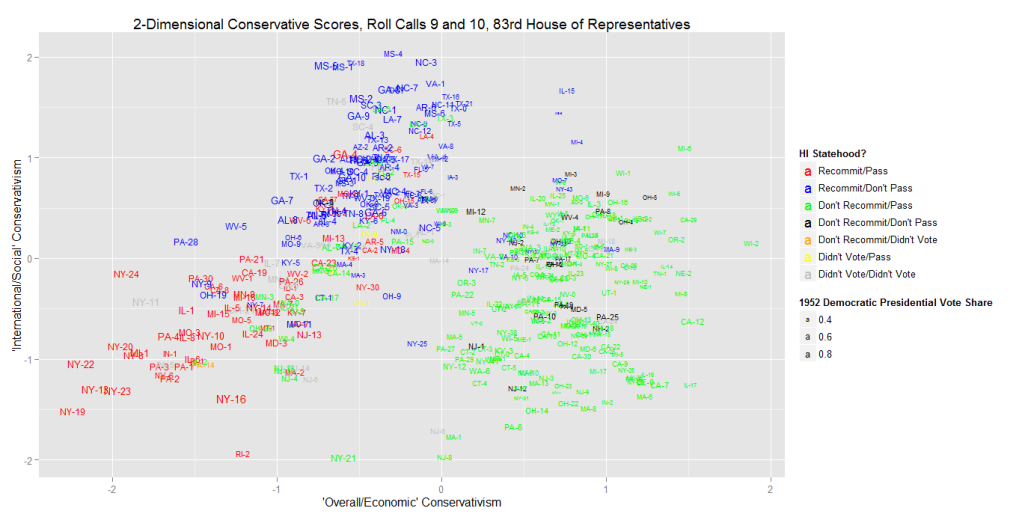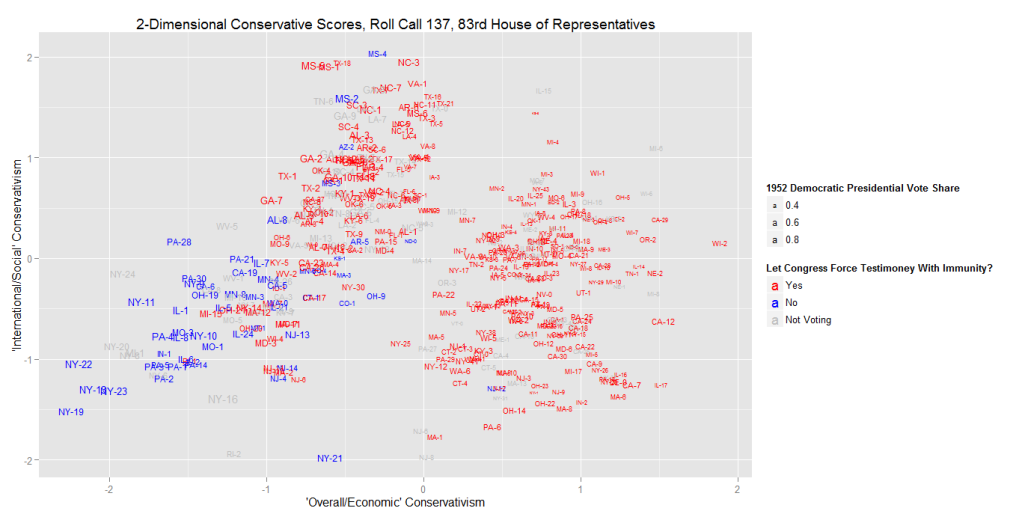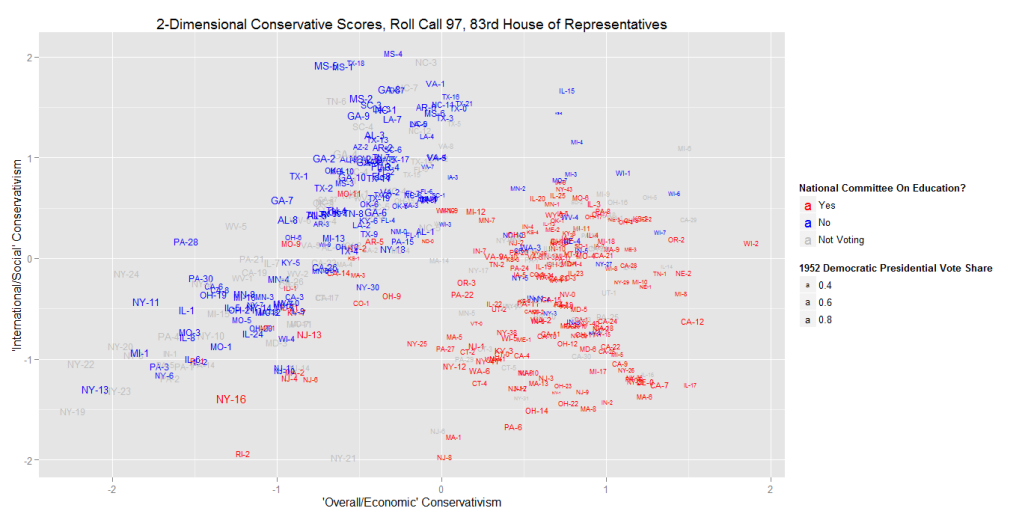In 1954, Democrats won back the House of Representatives after losing it in 1952, and despite my irritation at the mistakes I found in the 1952 results by Congressional district, there are still ways to look at the 1952 and 1954 elections. For example, OurCampaigns has vote totals and vote margins for each of the winning candidates, and it's not hard to turn that into each candidates' two-party vote share (assuming a general election between a Democrat and a Republican. Let's see what we can find out.
Here is a scatterplot (you should be able to click to enlarge) showing how the Democratic vote share of the individual House candidates changed from 1952, when Democrats lost the House, to 1954, when Democrats won it back.

Incidentally: note how many California seats are markedly more competitive in 1954 than in 1952, including the Democratic pickup in previously-uncontested CA-12. One reason? A new law that forced candidates to run with their party labels. Previously, a number of incumbents were able to run essentially uncontested after "cross-filing" and winning both the Democratic and Republican nominations in their district on pure name recognition--without identifying their own party. (See "Democrats Press California Drive", New York Times, November 7th, 1954.)
Anyway, let's zoom in to, more or less, the seats that were contested in 1954.
We can see that it was a fairly "orderly" election, as Nate Silver once put it about 2010. Democrats mostly picked up seats that they only lost narrowly in 1952.
There are a few exceptions. Democrats picked up WI-09 and NJ-06 in special elections after the popular Republican incumbents died (WI-09's Merlin Hull) or went on to higher office (NJ-06's Clifford Case). The Presidential numbers I have still show both districts as heavily Republican in 1952, so that still doesn't explain how Democrats did that well afterwards.
Democrats also picked up NY-21 in a landslide after the unique Republican incumbent, Jacob Javits, ran successfully for Attorney General. And Democrats also beat CA-12's Allen Hunter, who had gone uncontested in 1952 (yay for cross-filing!).
Overall, Democrats picked up 23 seats. In 13 of them, the 1952 Democratic candidate had gotten at least 47% of the vote (rounding). The exceptions are the ones mentioned above (NY-21, CA-12, WI-09, and NJ-06) and a few more: MN-9 (northwest Minnesota), where Coya Knutson beat Harold Hagen; IL-25 (south Illinois), where Kenneth Gray beat Runt Bishop; IL-12 (north Chicago), where Charles Boyle beat Edgar Jonas; IL-03 (southwest Chicago), where James Murray beat Fred Busbey; and OR-03 (Portland/Multnomah County) where Edith Green succeeded Homer Angell, after Angell lost a primary to future Oregon Governor Tom McCall. But even in most of those, the 1952 Democratic candidate had gotten at least 45%, except for MN-09, IL-25, and IL-12.
Here are the seats where Democrats got between 45% and 55% in 1952--again, that's most of the Democratic pickups:

Republicans picked up 5 seats. Four were heavily Republican. In two, TX-05 (Dallas) and OH-15, the Democratic incumbents retired or resigned. Republicans also beat Democratic incumbents in heavily Republican KS-01 (where Democrat Howard Miller beat a Republican incumbent in a 1952 fluke) and in FL-01.
Republicans also beat a Democratic incumbent in CA-06, a district so Democratic it voted for Stevenson in 1952. I think. The Democratic incumbent, Robert Condon, only won narrowly in 1952 anyway.
After getting to Congress, Condon, perpetually rumored to be an actual Communist, was "labeled a security risk by the Atomic Energy Commission". That probably didn't help in 1954, but he only lost narrowly.
What kinds of seats were these?
Many of the seats that went Democratic or came close in 1954 were urban: OR-03 (Portland), IL-03 and IL-12 (both entirely within Chicago, I think), MO-04 and MO-06 (rural, but I think also going right up to Kansas City), MI-17 (outer Detroit), WI-05 (north Milwaukee), and MA-08 (north Boston suburbs). NJ-12 (outer Essex county) was reasonably close to switching in both 1952 and in 1954. NJ-06 (coterminous with Union County) was one of the seats that flipped in a special election. The 1956 CQ Almanac has rural/urban percentages by district: MO-04 was 58% urban and MO-06 was 43% urban, but the rest mentioned here were nearly 100% urban. And Javits' NY-21 was certainly an urban seat, although not really a marginal one outside of Javits.
A few others might have been "broader South" districts at the time, like IL-25 (southern Illinois, 40% urban), IN-08 (southern Indiana, 57% urban), and certainly the Appalachian VA-09 (28% urban; the Republican who lost this time would come back, and eventually lose to Rick Boucher) and WV-04 (later Ken Helcher's district).
I'm not sure where DE-AL (63% urban) or MD-05 (49% urban) or MI-06 (Lansing area, 73% urban), or the PA seats (83% urban PA-11, 51% urban PA-19, and 58% urban PA-25 all went Democratic) fall.
But the overall pattern makes sense. Democratic strength was concentrated in city cores and in the solid south, and so swing seats would logically seem to be common at the peripheries of those regions: in urban areas outside of the cores, and in the border South.
Exceptions and Presidential Numbers:
Recall that chart showing the seats where Democrats got between 45% and 55% in 1952. It included nearly all of the Democratic pickups in 1954. But we can also see that there are a few districts--NV-0, WA-3, VA-6--where Democrats got pretty close in 1952, and didn't get close to winning in 1954. For example, in VA-06, Republican Richard Poff relatively narrowly beat incumbent Democrat Clarence Burton in 1952, and coasted in 1954.
In fact, if we color by the type of election in 1952, then we can see that, even though Democrats lost the House in 1952 and then won the House back in 1954, it wasn't necessarily the same seats that flipped back and forth.
And here's the range of seats that Democrats lost in 1952:

Democrats lost some seats by wide margins in 1952, and some seats they held before (at least on paper--redistricting might mean some of the seats I call "Democratic-Held" had changed significantly) by wide margins in 1954. But they picked up some new seats (or at least "new" relative to 1950).
Some of this is clarified if we look at the 1952 House results vs. the Presidential numbers I have from the CQ Almanac--I hesitate a bit to include this, because I'm still not sure about these numbers, and my own county-by-county numbers didn't match in South Carolina (or, to some extent, elsewhere, but much of that is surely because they use Ike's raw percentage, not two-party vote share).
I think they're considerably better than the District Data Book numbers. But they're not from an entirely independent source (the Almanac, like the District Data Book, consulted the Republican Congressional Committee, but also consulted the DNC and did their own research). Take them with a grain of salt, but I think they provide useful context.

That's a pretty good fit, actually--and most of the exceptions are Jacob Javits, uncontested California seats, and the solid South. That makes me pretty confident about these numbers.
Here's just the reasonably-contested seats that went Republican in 1952. This is, basically, the Republicans' majority:
 VA-06, CA-21, CA-09, OH-16, UT-02, VA-10 and NV-AL were all relatively close at the House level in 1952, but at the Presidential level, they were apparently on the Republican side. So the close 1952 results were probably not reflective of the seats' true natures. (How they managed to go Democratic in the first place might be more interesting.)
VA-06, CA-21, CA-09, OH-16, UT-02, VA-10 and NV-AL were all relatively close at the House level in 1952, but at the Presidential level, they were apparently on the Republican side. So the close 1952 results were probably not reflective of the seats' true natures. (How they managed to go Democratic in the first place might be more interesting.)For example, in OH-16, the Republican incumbent was drawn together with a former Democratic incumbent in 1952, and had an easier re-election in 1954. And it's no surprise that a Democratic incumbent in super-Republican NY-01 lost easily in 1952.
The seats that were marginal at the House level seem to have been generally marginal seats at the Presidential level as well, overall.

And here's just the close races in 1954:

Assuming the Presidential results are (mostly) right, we can see that Democrats mostly won back the House by beating Republican incumbents in moderate-to-Democratic districts. Most of the Democratic pickups were in districts with a rather narrow range of Eisenhower percentages, according to the CQ Almanac--about 55% to 60%. CA-12 no longer looks like a surprising Democratic win (and CA-06 looks like a more surprising Democratic loss).
We can also see that only a few Democrats had seats where Eisenhower got at least 60% of the vote, especially outside the South: Aspinall, in CO-04; Johnson, in WI-09; Pfost, in ID-01; Williams, in NJ-06; and Marshall, in MN-06. Even more impressively, only two of them faced close elections in 1952. And only a very few Stevenson seats were close. The considerably majority of close races were in seats where Eisenhower got between 50% and 60% of the vote, or roughly R+5 to D+5 seats. Not unlike today.
An Ideological Perspective.
Finally, here's another perspective: The one-dimensional conservativeness scores (ideal points) for the 83rd House and the 84th House, plotted against each other. Note the dramatic changes in all of the seats that changed parties.
We can see that Oakley Hunter, in CA-12, was a very conservative Republican incumbent--in a district that apparently narrowly voted for Stevenson. It's not terribly surprising that he'd be in trouble once he had to run with a party label.
We can also see that MI-06--apparently the reddest seat where a Republican incumbent lost in 1954--had an even more conservative Republican incumbent, Kit Clardy. According to Wikipedia, Clardy was known as "Michigan's McCarthy, referring to his affinity for the controversial anti-communist U.S. Senator Joseph McCarthy." Clardy apparently focused on serving on HUAC. Again, this likely helps explain why he was relatively weak in 1952, and how he lost in 1954 in a relatively Republican seat. (His 1952 win wasn't very impressive either.) He was probably something like an Allen West or a Marilyn Musgrave of the time.
But here is why it's good to combine quantitative and qualitative research:
The Republican incumbent in WI-05 (north Milwaukee) was one Charles Kersten. Algorithmically, he was one of the most moderate Republicans to lose in 1954. He voted with liberal Democrats on stopping a Mexican agricultural worker program and with most Democrats on public housing funds.
However, this isn't necessarily how Kersten campaigned. A November 4, 1954 New York Times editorial, "The Congressional Election", referred to him as a "McCarthy sympathizer", and a November 6, 1954 Washington Post editorial ("Wisconsin Decision") referred to Kersten as "the leading McCarthy Republican in the state, who "a la Nixon, charged that his Democratic opponent was 'soft on communism'". Kersten won in the first place over liberal incumbent Andrew Biemiller after a campaign where Kersten brought up Biemiller's past as a Socialist. (Chicago Daily Tribune, September 26, 1946, "Kersten Digs up Biemiller's Past as Legislator". Biemiller had in fact been, literally, a Socialist. Anyway.)
Despite Kersten's moderate voting record, perhaps his campaigning style ended up working against him. He only barely won anyway--as an incumbent--in 1952.
I think that 1954, or perhaps the combination of 1952 and 1954, were what Nate Silver (again about 2010) called an "aligning" election. Democrats and Republicans traded a few fluke seats--Democrats gave up OH-15, TX-05, and KS-01, and Republicans gave up CA-12 and NY-21. Beyond that, Democrats had sufficient improvement to win back a bunch of seats they only lost narrowly in 1952 that were (apparently) mostly swing seats at the Presidential level.
Still, it's interesting to see what a "status quo" change of party control looked like in 1952. There were multiple swing seats in major cities, including Portland, Oregon. Looking back, we might see this as an early part of the end of the Democratic South. (A Republican elected in Texas! I found an amazed newspaper article or two. I looked on ProQuest for these articles, incidentally.)
Next up: A look at roll call voting in the 84th House.


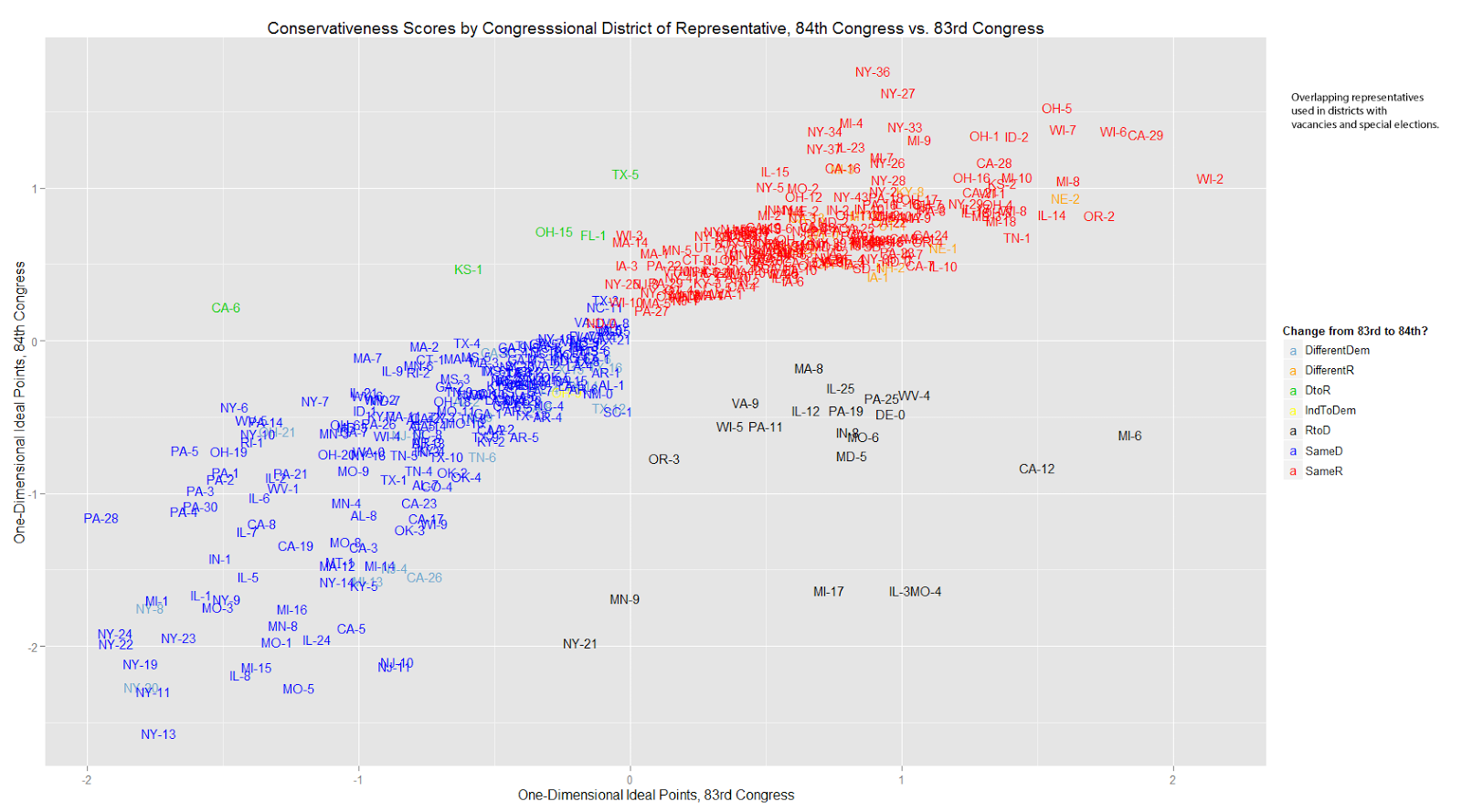.png)
